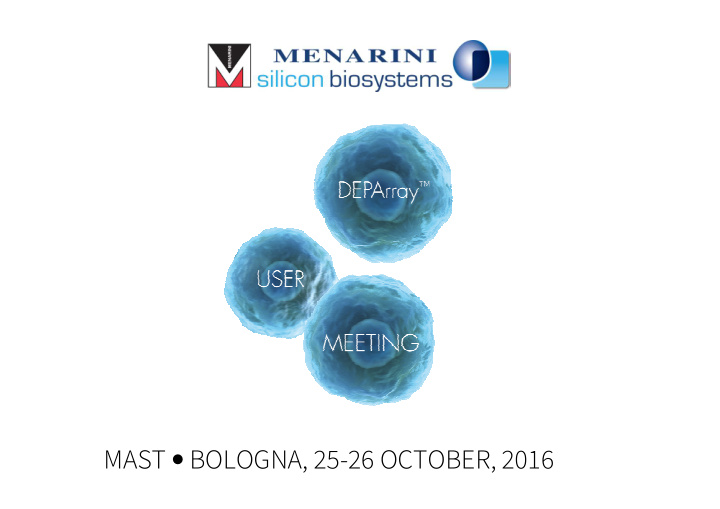



MAST • BOLOGNA, 25-26 OCTOBER, 2016
DEPArray™ User Meeting Setup of a DEPArray-Based Protocol for Sorting Single Neural Cells Potentially Carrying PI3K/AKT/mTOR Genes Mutations Valerio Conti, PhD Pediatric Neurology, Neurogenetics and Neurobiology Unit and Laboratories, Neuroscience Department, A Meyer Children’s Hospital, University of Florence, Florence, Italy. valerio.conti@meyer.it MAST • BOLOGNA, 25-26 OCTOBER, 2016
Main research areas of the Center of Excellence in Neurosciences, Children’s Hospital Meyer • Epileptic encephalopathies with seemingly non-lesional origin: • Phenotype definition • Genetic causes • Exploring functional consequences • Treatment & prevention • Epileptogenic malformations of cortical development: • Phenotype definition • Genetic causes • Exploring functional consequences • Treatment & prevention MAST • BOLOGNA, 25-26 OCTOBER, 2016
Main research areas of the Center of Excellence in Neurosciences, Children’s Hospital Meyer • Epileptic encephalopathies with seemingly non-lesional origin: • Phenotype definition • Genetic causes • Exploring functional consequences • Treatment & prevention • Epileptogenic malformations of cortical development: • Phenotype definition • Genetic causes • Exploring functional consequences • Treatment & prevention MAST • BOLOGNA, 25-26 OCTOBER, 2016
PI3K/AKT/MTOR pathway From KEGG: http://www.genome.jp/kegg/kegg2.html MAST • BOLOGNA, 25-26 OCTOBER, 2016
PI3K/AKT/MTOR pathway and neurological diseases • Mutations in genes belonging to the PI3K/AKT/MTOR pathway have been associated with a wide neurological phenotypic spectrum: - TSC1/TSC2: Tuberous Sclerosis; - AKT3 , PIK3CA, MTOR, DEPDC5, NPRL2, NPRL3: Type Ib, IIa and IIb FCD, HME, MEG; - PTEN : MAEP; - PIK3CA : MPPH, MCAP, BPP with or without macrocephaly. • The number of clinical conditions in which developmental brain abnormalities, epilepsy, intellectual disability, and autism are variably associated and that are caused by different somatic or constitutional mutations involving the PI3K/AKT/MTOR pathway is growing. MAST • BOLOGNA, 25-26 OCTOBER, 2016
Focal VS diffuse MCDs FOCAL MALFORMATIONS DIFFUSE MALFORMATIONS (e.g. FCD) (e.g. DYSPLASTIC MEGALENCEPHALY) EPILEPSY SURGERY NGS STUDIES ON DYSPLASTIC BRAIN SPECIMENS MAST • BOLOGNA, 25-26 OCTOBER, 2016
The background noise issue… • … each human cortical neuron has a profoundly distinctive genome, harboring as many as 1458 to 1580 somatic single nucleotide variants, in addition to large copy number variants and occasional retro-element insertions … • … most of these variants reflect DNA damage during active transcription and are related to physiological neuronal aging and neurodegenerative diseases… Lodato et al., Science. 2015;350:94-8 Mosaic variants that arose during development and are causative for brain malformations in patients. MAST • BOLOGNA, 25-26 OCTOBER, 2016
The mosaicism issue… • The capability to detect these mutations directly depends from the percentage of cells carrying them. • High-throughput sequencing of DNA isolated from thousands of cells from brain specimens, although useful, is unable to detect mutations present in small numbers o cells. SOMATIC MOSAICISM > 10% MAST • BOLOGNA, 25-26 OCTOBER, 2016
Target cytological subtypes HME Autoptic control PQD Dysplastic, cytomegalic neuron Normal cortical neuron Balloon cell Anti-p-RPS6 MAST • BOLOGNA, 25-26 OCTOBER, 2016
DEPArray protocol setup Fibroblasts cultures from a patient with BPP and macrocephaly carrying the Gly373Arg mosaic mutation in PIK3R2 (Mirzaa et al., Lancet Neurol. 2015) STEP 1 Single cells separation, WGA, mutation validation and genotype/phenotype correlation Evaluation of the phenotype in dysplastic brain specimens and STEP 2 genotype/phenotype correlation for a known mutation NGS analysis of dysplastic brain specimens for STEP 3 molecular diagnosis MAST • BOLOGNA, 25-26 OCTOBER, 2016
Step 1: fibroblasts HOECHST FITC (p-RPS6) MERGE BRIGHTFIELD Fibroblast_Cell Id = 985 HOECHST FITC (p-RPS6) MERGE BRIGHTFIELD Fibroblast_Cell Id = 2257 n = 6 MAST • BOLOGNA, 25-26 OCTOBER, 2016
Step 2: dysplastic brain specimens HOECHST FITC (p-RPS6) MERGE BRIGHTFIELD Brain cell_Cell Id = 7892 HOECHST FITC (p-RPS6) MERGE BRIGHTFIELD Brain cell_Cell Id = 6760 n = 1 MAST • BOLOGNA, 25-26 OCTOBER, 2016
Conclusions and future directions • The DEPArray has the capability of recognizing and separating aberrant cells carrying mutations in genes of the PI3K/AKT/mTOR pathway. • Massive parallel sequencing protocol for analyzing samples carrying known mutations. • Massive parallel sequencing studies in samples from patients without molecular diagnosis. MAST • BOLOGNA, 25-26 OCTOBER, 2016
Center of Excellence in Neurosciences Meyer Children’s Hospital Prof. Renzo Guerrini Pediatric Neurology Neurogenetics Lab Unit Claudia Bianchini Neurobiology Lab Carmen Barba Elena Cellini Valentina Ariu Emanuele Bartolini Laura Chiti Valentina Cetica Sara Chiari Dalila De Vita Cristiana Pelorosso Viola Doccini Davide Mei Carla Marini Elena Parrini Francesco Mari Daniela Pucatti Federico Melani Domenico Rutigliano Martino Montomoli Simona Virdò Silicon Biosystems Tiziana Pisano Alessandra Totaro Anna Rosati Giulia Bregola
Recommend
More recommend